Unit 6 Survival Starting out & Understanding ideas课件(共52张PPT)-高中英语外研版(2019)选择性必修第二册(共53页PPT)
文档属性
| 名称 | Unit 6 Survival Starting out & Understanding ideas课件(共52张PPT)-高中英语外研版(2019)选择性必修第二册(共53页PPT) | 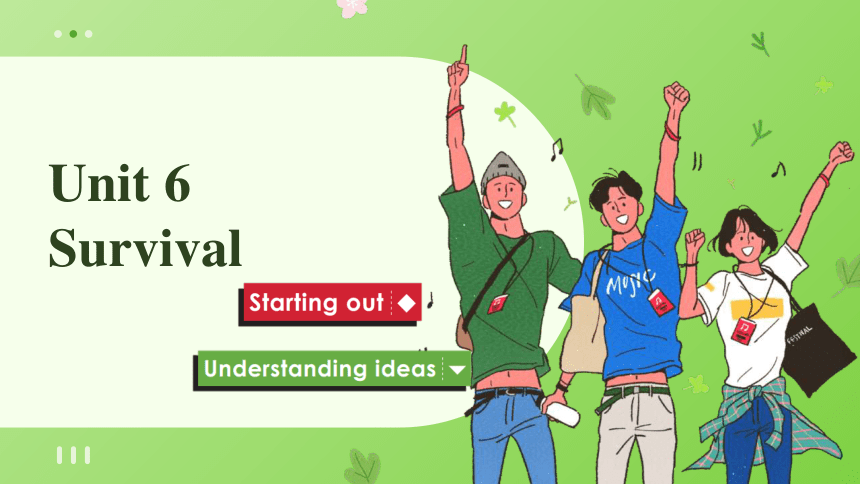 | |
| 格式 | pptx | ||
| 文件大小 | 131.5MB | ||
| 资源类型 | 教案 | ||
| 版本资源 | 外研版(2019) | ||
| 科目 | 英语 | ||
| 更新时间 | 2025-07-04 17:00:42 | ||
图片预览

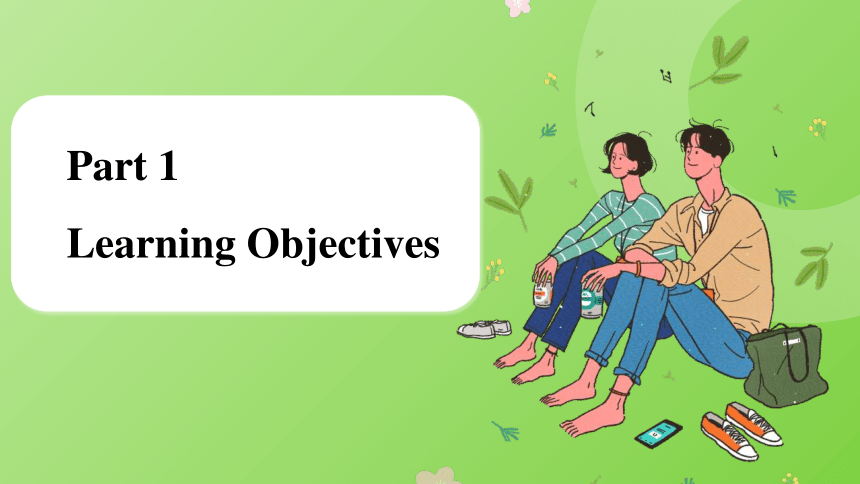
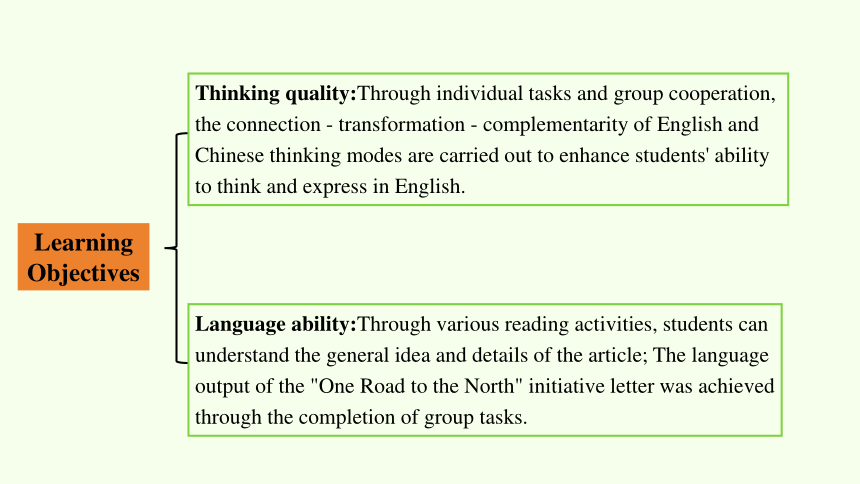
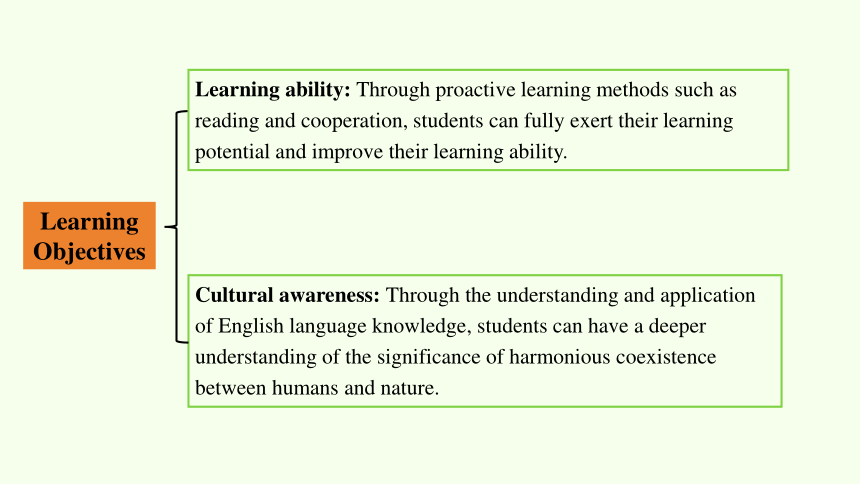
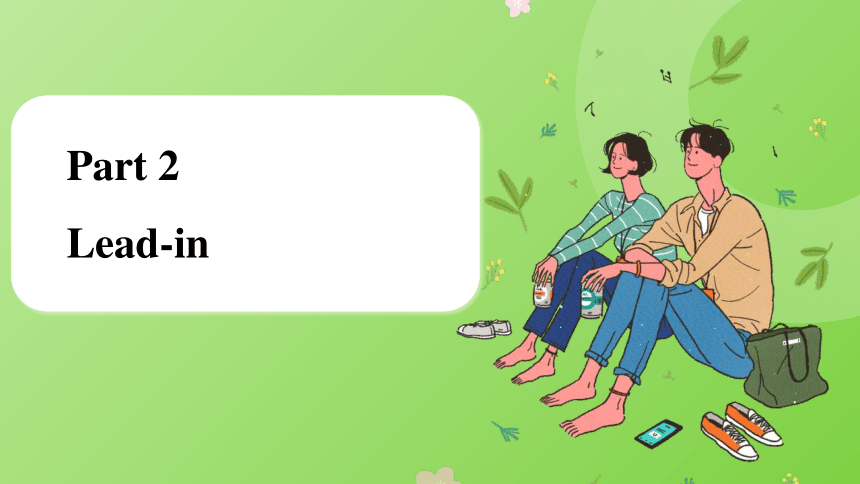
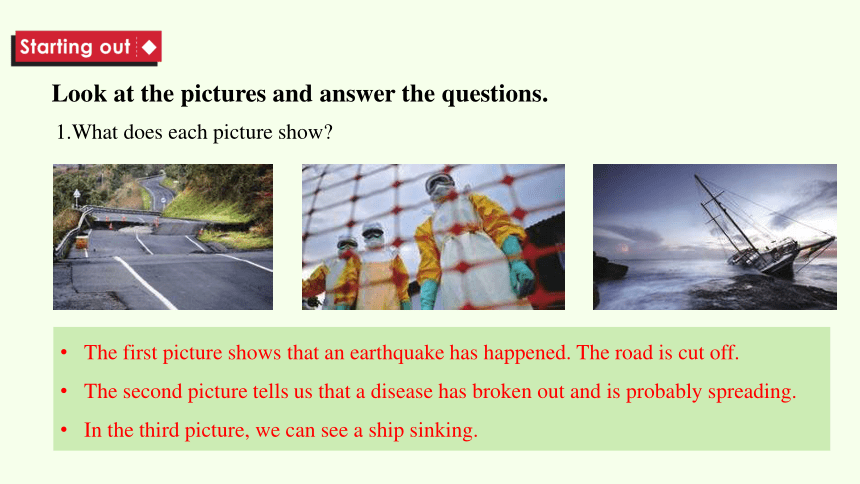
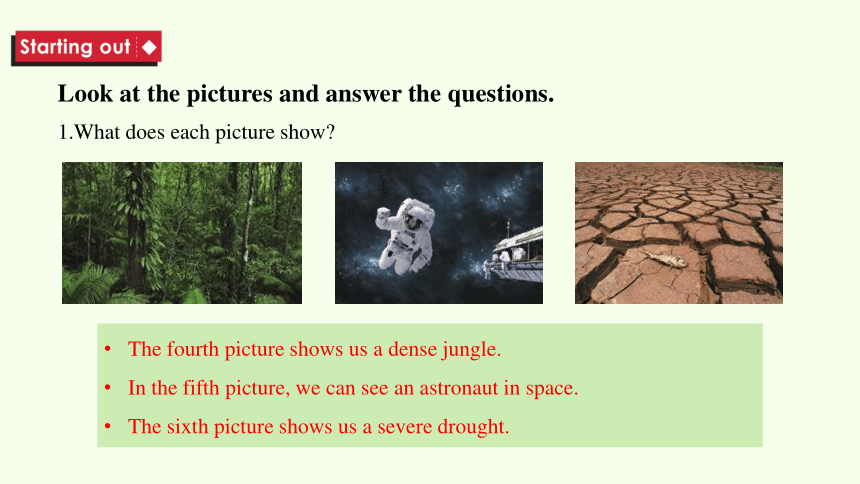
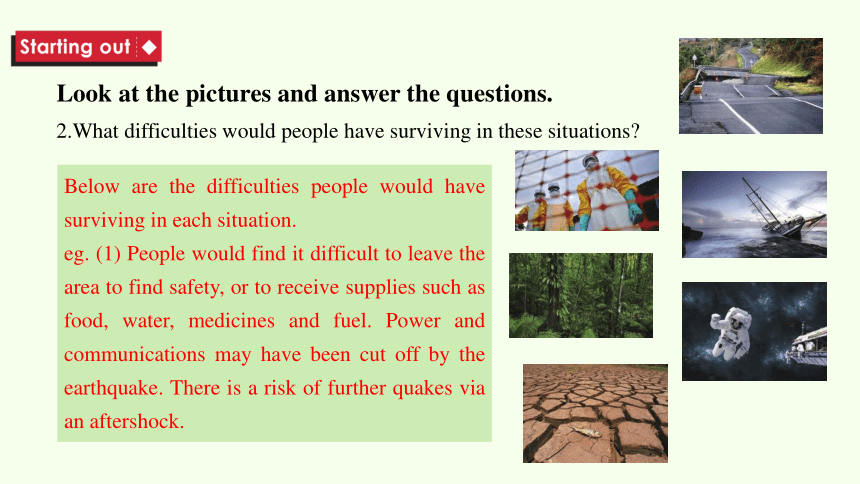
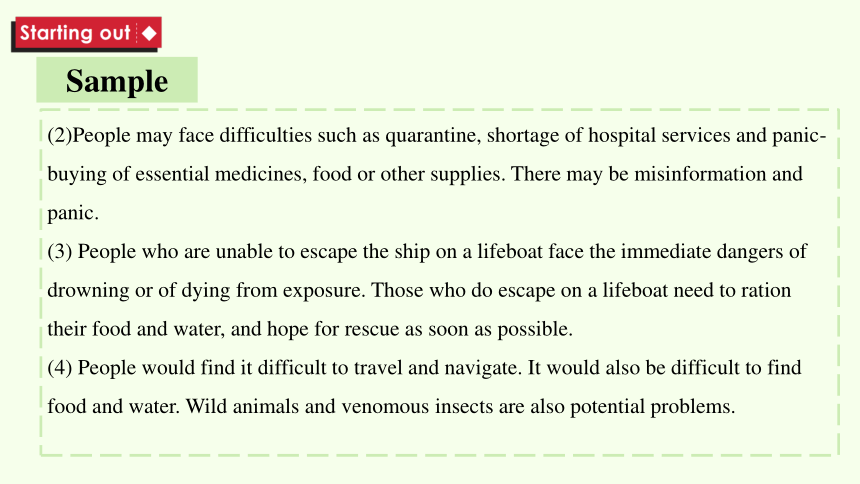
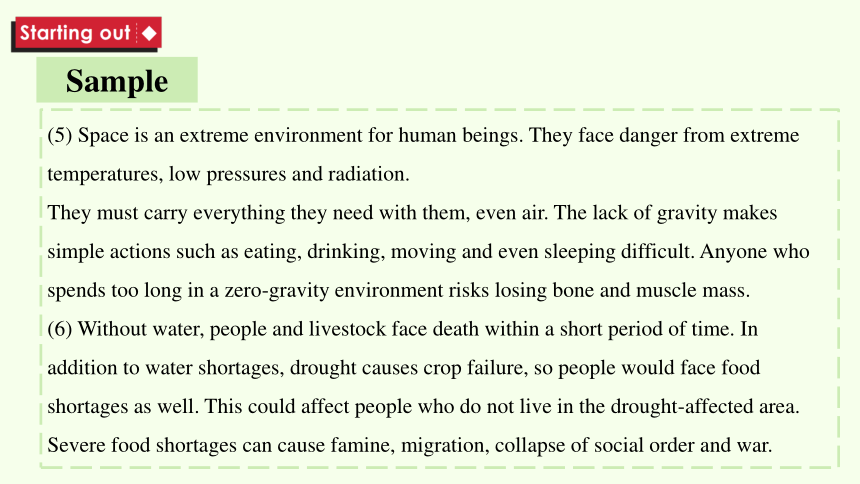
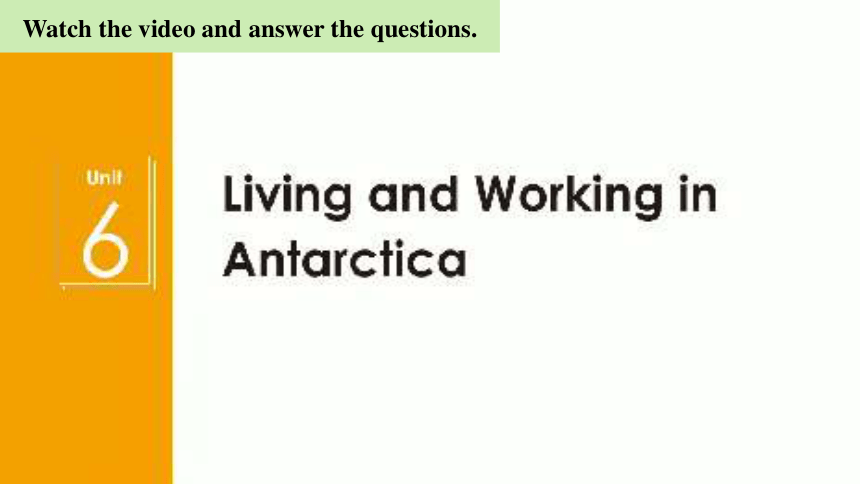
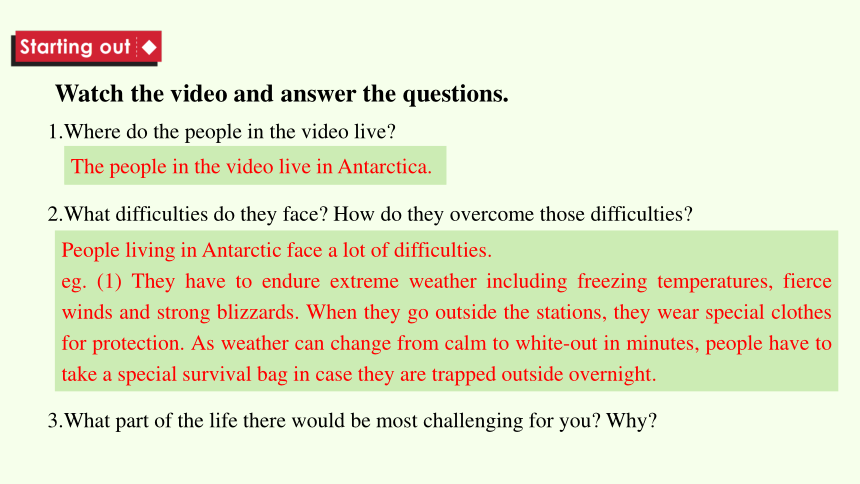
文档简介
(共52张PPT)
Unit 6
Survival
Part 1
Learning Objectives
Learning Objectives
Language ability:Through various reading activities, students can understand the general idea and details of the article; The language output of the "One Road to the North" initiative letter was achieved through the completion of group tasks.
Thinking quality:Through individual tasks and group cooperation, the connection - transformation - complementarity of English and Chinese thinking modes are carried out to enhance students' ability to think and express in English.
Learning Objectives
Cultural awareness: Through the understanding and application of English language knowledge, students can have a deeper understanding of the significance of harmonious coexistence between humans and nature.
Learning ability: Through proactive learning methods such as reading and cooperation, students can fully exert their learning potential and improve their learning ability.
Part 2
Lead-in
Look at the pictures and answer the questions.
1.What does each picture show
The first picture shows that an earthquake has happened. The road is cut off.
The second picture tells us that a disease has broken out and is probably spreading.
In the third picture, we can see a ship sinking.
Look at the pictures and answer the questions.
1.What does each picture show
The fourth picture shows us a dense jungle.
In the fifth picture, we can see an astronaut in space.
The sixth picture shows us a severe drought.
Look at the pictures and answer the questions.
2.What difficulties would people have surviving in these situations
Below are the difficulties people would have surviving in each situation.
eg. (1) People would find it difficult to leave the area to find safety, or to receive supplies such as food, water, medicines and fuel. Power and communications may have been cut off by the earthquake. There is a risk of further quakes via an aftershock.
Sample
(2)People may face difficulties such as quarantine, shortage of hospital services and panic-buying of essential medicines, food or other supplies. There may be misinformation and panic.
(3) People who are unable to escape the ship on a lifeboat face the immediate dangers of drowning or of dying from exposure. Those who do escape on a lifeboat need to ration their food and water, and hope for rescue as soon as possible.
(4) People would find it difficult to travel and navigate. It would also be difficult to find food and water. Wild animals and venomous insects are also potential problems.
Sample
(5) Space is an extreme environment for human beings. They face danger from extreme temperatures, low pressures and radiation.
They must carry everything they need with them, even air. The lack of gravity makes simple actions such as eating, drinking, moving and even sleeping difficult. Anyone who spends too long in a zero-gravity environment risks losing bone and muscle mass.
(6) Without water, people and livestock face death within a short period of time. In addition to water shortages, drought causes crop failure, so people would face food shortages as well. This could affect people who do not live in the drought-affected area. Severe food shortages can cause famine, migration, collapse of social order and war.
Watch the video and answer the questions.
Watch the video and answer the questions.
1.Where do the people in the video live
2.What difficulties do they face How do they overcome those difficulties
3.What part of the life there would be most challenging for you Why
The people in the video live in Antarctica.
People living in Antarctic face a lot of difficulties.
eg. (1) They have to endure extreme weather including freezing temperatures, fierce winds and strong blizzards. When they go outside the stations, they wear special clothes for protection. As weather can change from calm to white-out in minutes, people have to take a special survival bag in case they are trapped outside overnight.
Sample
(2) One of the most difficult things is the long days and nights. They may cause issues with the scientists' body clocks. The darkness also makes outdoor research impossible.
(3) It is almost impossible to grow fresh produce there because of the extreme conditions, and most food is imported. It is difficult for scientists to have a varied diet, and they can't get enough fresh fruit and vegetables.
(4) They have to face psychological problems.
To keep the scientists psychologically healthy, research stations offer activities and entertainment including live music and lectures.
Think and Share
What do you think of when you think of ‘human and nature’
Ecosystem
Harmonious coexistence
Pollution
Extinction (species disappearing)
Ecological restoration
Awe of Nature
Green energy
Community of life
Watch the video
Part 3
Reading
pre-reading
Look at the picture and answer the questions.
1.Where would you normally expect to find these animals
2.Would you be surprised to see these animals in a city Why or why not
3.What problems could they encounter in cities
fox
leopard
bear
racoon
chacma baboon
hedgehog
pre-reading
Look at the picture and answer the questions.
1.Where would you normally expect to find these animals
2.Would you be surprised to see these animals in a city Why or why not
3.What problems could they encounter in cities
In the wild.
Yes. Because they are normally in the wild, and they are sometimes dangerous for humans. It’s also difficult for them to find shelters and food in the cities.
They may have difficulty finding food, shelter and mates. If people find them, they may be trapped or killed.
pre-reading
Background information:
1. Fox
There are several animals which are known as foxes, but generally when people think of a fox, they mean the iconic red. The red fox is a member of the so-called "true foxes", a group which also includes the Arctic fox, the desert-dwelling fennec fox (with its distinctive large ears), and a number of other less well-known species.
1. 狐狸
有几种动物被称为狐狸,但通常当人们想到狐狸时,他们指的是标志性的红色。红狐是所谓“真狐”的一员,真狐还包括北极狐、生活在沙漠中的耳廓狐(长着独特的大耳朵),以及其他一些不太为人所知的物种。
pre-reading
Background information:
2. Leopard
Leopards are found mostly in sub-Saharan Africa, with small ranges remaining in Western and Central Asia, in India, and in South-east and East Asia. It is well known for its yellowish fur and distinctive spots, though leopards with black coats, known as panthers, also occur. It may be found in a large range of wild habitats, but primarily in savanna and rainforest.
2. 豹
豹子主要分布在撒哈拉以南的非洲,在西亚和中亚、印度、东南亚和东亚也有少量分布。它以黄色的皮毛和独特的斑点而闻名,尽管也有黑色皮毛的豹子,被称为黑豹。它可以在很多野生栖息地找到,但主要是在热带草原和雨林。
pre-reading
Background information:
3. Bear
Bears are large mammals of the family Ursidae.
There are only eight species of bear, which may be found in North America, South America, Europe and Asia. Bears have large bodies, stocky legs, long snouts, small rounded ears and short tails. As for many carnivores, the males are generally larger than the females, and in larger bear species, this difference is more marked.
3. 熊
熊是熊科的大型哺乳动物。
世界上只有八种熊,分布在北美、南美、欧洲和亚洲。熊身体大,腿粗,鼻子长,耳朵小而圆,尾巴短。对于许多食肉动物来说,雄性通常比雌性大,在大型熊类中,这种差异更为明显。
pre-reading
Background information:
4. Racoon
The racoon is a medium-sized mammal with grey fur and a very distinctive dark pattern around its eyes, which makes it look like it is wearing a mask. It also has a ringed tail, and is very good at manipulating objects with its front paws. Racoons are highly intelligent animals, and some studies indicate that they can remember the solutions to novel tasks for at least three years.
4. 浣熊
浣熊是一种中等大小的哺乳动物,有着灰色的皮毛,眼睛周围有一种非常独特的深色图案,这让它看起来像是戴着面具。它也有一个环形的尾巴,并且非常擅长用它的前爪操纵物体。浣熊是非常聪明的动物,一些研究表明,它们可以记住新任务的解决方案至少三年。
pre-reading
Background information:
5. Chacma baboon
The chacma baboon, also known as the Cape baboon, is one of the largest of all monkeys. It is perhaps the longest species of monkey and also one of the heaviest. It is generally dark brown to grey in colour, with a patch of rough hair on the nape of its neck. It is primarily found in southern Africa, including South Africa, Angola, Zambia and Mozambique.
5. 大狒狒
chacma狒狒,也被称为海角狒狒,是所有猴子中最大的一种。它可能是最长的猴类,也是最重的猴类之一。它的颜色通常是深棕色到灰色,颈背上有一小块粗糙的毛。它主要分布在非洲南部,包括南非、安哥拉、赞比亚和莫桑比克。
pre-reading
Background information:
6. Hedgehog
Hedgehogs are small spiny mammals that feed largely on slugs and insects, though they will also eat fruit, birds' eggs and carrion. They are known for their habit of rolling into a ball when threatened, using their spines to protect themselves. Hedgehogs are native to Europe, Asia and Africa, and are also found as an invasive species in New Zealand, where they were unwisely introduced by European settlers.
6. 刺猬
刺猬是一种多刺的小型哺乳动物,主要以蛞蝓和昆虫为食,不过它们也会吃水果、鸟蛋和腐肉。众所周知,当受到威胁时,它们会蜷成一团,用它们的刺来保护自己。刺猬原产于欧洲、亚洲和非洲,在新西兰也被发现是一种入侵物种,欧洲殖民者不明智地将它们引入了新西兰。
pre-reading
Look at the title of the passage and the picture. Think about what the title means.
PREDICITING
In this picture, we can see a squirrel, birds, butterflies and some racoons. These animals are living in a city which is ruled by human beings.
The title means the wild animals within the cities.
while-reading
Choose the topic sentences for Paragraphs 2-5 and write them on the lines to complete the passage.
SKIMMING
a One thing crucial to the increasing number of “urban animals” is their ability to adapt.
b People often wonder about the reasons behind this mass urban migration.
c For those animals that don't adapt, the city can be a dangerous or even deadly place.
d Yet, for its newest and wildest inhabitants, a city can offer many benefits.
Para. 2—b Para. 3—d Para. 4—a Para. 5—c
while-reading
SKIMMING
Match the paragraphs with the main ideas.
para. 1
para. 2
para. 3
para. 4
para. 5
para. 6
The benefits that a city can offer to these newcomers.
More and more wild animals are entering our cities.
Wild animals’ ability to adapt themselves to the city life.
We should get a better understanding of these wildanimals.
The reason behind this mass urban migration.
Dangers for some animals that can't adapt.
while-reading
SKANNING
Organise information from the passage and complete the diagram.
Reasons for migration:
Urban
development and climate change push the animals1.__________________________
2.__________________________________________________________________________________________________________________________________
out of their natural habitats
Wherever they go, animals find towns and cities in their way. With nowhere else to make their homes, they have no choice but to move in with us.
while-reading
SKANNING
Organise information from the passage and complete the diagram.
Benefits of cities for animals:
Appealing spaces as habitats.
3.__________________________________________________________________________________________________________________________________
4.__________________________________________________________________________________________________________________________________
Out of reach from many of their natural predators, these newcomers often flourish in their new city lives.
Hungry animals are finding plenty to eat in our gardens and in the leftovers we throw away.
while-reading
SKANNING
Organise information from the passage and complete the diagram.
Animals’ adaption to cities:
Urban animals are more 5.________________________________.
6.______________________________________________________________________________________________________________________________
intelligent than their wild cousins
Some animals have even changed their living habits to fit in with their new homes.
while-reading
SKANNING
Organise information from the passage and complete the diagram.
Dangers for some animals:
7.______________________________________________________________________________________________________________________________
8.______________________________________________________________________________________________________________________________
We should learn to better understand and appreciate our wild neighbours, and 9.________________________________________________________________
Some birds crash into windows because they are unable to distinguish between blue sky and glass.
Some birds have yet to change their migratory routes that take them through cities with high-rise buildings.
look towards harmoniously sharing our urban habitats
while-reading
INTENSIVE READING
Choose the correct answer according to the content of the text.
1. Why does the author talk about the " theft" in Cape Town in Paragraph 1
A. To give us some warnings.
B. To introduce the topic of the text.
C. To show us how animals live in the city.
D. To call on us to take care of wild animals.
2. What's Paragraph 3 mainly about
A. Animals' flourishing in cities.
B. Benefits of cities for wild animals.
C. A great amount of food wasted by humans.
D. The relationship between animals and humans.
while-reading
3. What does the author mean by saying " urban foxes come out in daylight" in Paragraph 4
A. They have no choice but to do so.
B. They are no longer afraid of humans.
C. They are more intelligent than wild foxes.
D. They have changed their living habits.
4. What's the author's purpose in writing the text
A. To call on us not to build skyscrapers in the urban areas.
B. To encourage us to have a better understanding of our wild neighbours.
C. To advise us to better protect our wild neighbours in cities.
D. To show us the sad stories of wild animals in cities.
INTENSIVE READING
Choose the correct answer according to the content of the text.
while-reading
INTENSIVE READING
Fill in the blanks in the grammar of the text.
Animals are 1 (frequent) reported to appear in cities like London, San Francisco and Hong Kong. It seems as if our cities are being taken over by wild animals.
2 is generally believed that urban 3 ( develop) and climate change are responsible for animals' entering our cities. However, we also need consider that it is we human beings that have moved into animals' territory.
It is an obvious fact 4 our cities appeal to wild animals very much. For one thing, they are quite out of reach from their natural predators and are able to live more safely.
frequently
It
development
that
while-reading
INTENSIVE READING
For another, they can find food more easily from the leftovers 5 (throw) away by human beings. Some wild animals are so 6 (intelligence) that they can figure out very difficult problems. Some wild animals even have changed their living habits 7 (fit) in with their new homes. However, with more high-rises 8 (show) up in the city, lots of birds get killed by crashing
9 the glass windows. Some even have to change their migratory routes due to the high buildings.
As many animals have got used to living in cities, we human beings ought to learn to appreciate our new10 (neighbour ). Only in this way can we live in peace with the animals.
thrown
intelligent
to fit
showing
into
neighbours
while-reading
INTENSIVE READING
taking over
cliamte change
their living habits
crash into windows
conclusion
post-reading
Humans build cities not only to make themselves live, also to let the wild animals survive.
When building cities, humans should not occupy the living space of wild animals.
It is a sign of modern civilization to let wild animals find habitats in cities just like human beings, which can contribute to a good biodiversity and a complete ecology.
Now think about what people can do to achieve a balance between the need for urban development and the protection of wild animals.
post-reading
Think & Share
1.How would you describe the relationship between people and urban animals in the passage
2.What figure of speech is used in the first paragraph Why does the author choose to start the passage this way
Animals have no choice but to live with us. We humans should learn to understand them, appreciate them and live with harmoniously.
In the first paragraph, the author uses personification to describe what urban animals are doing, with the aim of attracting readers’ attention.
post-reading
Think & Share
3.Some environmentalists argue that we should restrict urban development to leave enough natural habitats for wild animals. Do you agree with this Give your reasons.
Yes, I agree with this opinion. With the acceleration of human urbanization, more and more animals' habitats have been destroyed or invaded. This has deprived the animals of their homes and food. They have nowhere to go and face threats to their survival. Therefore, human beings should slow down the speed of urbanization.
Vocabulary
1. impact
have an impact on sth./sb.对……有影响
impact on/upon sth.对……造成影响
练习:帮助残疾人的建议产生了积极的反响,对年轻一代的影响将是持久的。
There has been positive reaction to the suggestion to help the disabled, the ________of
which will be lasting for younger ones.
impact
Vocabulary
2. crash
crash(...)into... (使…)撞上……
a car crash 汽车撞车事故
a plane crash 飞机失事
练习:许多投资者在最近的股票市场暴跌中损失惨重。
Many investors suffered huge losses in the recent stock market ________.
crash
Vocabulary
3. commit
commit a mistake 犯错误
commit a crime 犯罪
commit suicide自杀
commit oneself to(doing)sth.承诺(做)某事
be commited to(doing)sth.承诺(做)某事
练习:吸烟不仅损害他人健康,还等于慢性自杀。
Smoking not only harms others’ health, but also is _____________ suicide slowly.
committing
Vocabulary
4. hesitate
hesitation n. 犹豫,迟疑
hesitant adj.犹豫的,迟疑的
hesitantly adv.犹豫地
hesitate to do sth 对做某事有顾虑
hesitate over/about sth. 对某事犹豫不决
练习:
All those clothes look smart and Anna hesitated___________which to buy.
about/over
Grammer
Spotting the car with its window left open, the greedy thief didn't hesitate.
with 复合结构
with 复合结构,即"with+宾语+宾补"结构,在句中通常作状语,表示伴随、方式、原因或条件等,也可作定语。宾语可由名词或代词充当。
She saw a river with red flowers and geen gass on both sides.
她看到一条两岸长着红花绿草的河流。
Grammer
with 复合结构
常见的 with 复合结构
with+宾语+分词:
现在分词(表示主动或动作正在进行);过去分词(表示被动或动作已完成)
with+宾语+动词不定式(通常用 to do 形式,表示动作尚未进行)
with+宾语+介词短语/形容词/副词(表示宾语所处的状态)
Grammer
with 复合结构
常见的 with 复合结构
The girl felt very safe with her mother standing behind her.
她的妈妈站在她的身后,这个女孩儿感到很安全。 (her mother与 stand 之间是逻辑上的主谓关系)
With all the things she needed bought,she went home.
买了她需要的所有西后,她回家了。(things与 buy 之间是逻辑上的动宾关系)
With so many books to read, I have no time to chat with you.
有这么多的书要读,我没时间跟你闲聊。
(books与read 之间是逻辑上的动宾关系,但不定式用主动形式表示被动意义)
Part 4
Exercise
Exercise
单词拼写
1.Faced with the evidence, he had no choice but to admit his c .
2.People of all ages can participate in this activity to help classify g , which will make their neighborhood clean and beautiful.
3.You should be happy with what you already have and not risk losing it by being
(贪婪的)and trying to get more.
4.It is not terrible to (犯) a mistake. The most terrible thing is the fear of it.
5.As cities balloon with growth, access to nature for people living in
(城市的)areas is becoming harder to find.
rimes
arbage
greedy
commit
urban
Exercise
语法填空
1.Winning the game is crucial the team, for the result will decide whether it can defend its title.
2.They estimate the cost to repair the car 800 yuan.
3.We should be of life. We should learn to kindness around us and show our of others' help in time. (appreciate )
4.The expert used environmental protection laws to explain a (restrict) on development in and around wetlands and the knowledge of wetland ecology to help improve the bad situation.
5.So far a great amount of work ( do) to improve our environment and amounts of money (put) into several projects.
to/for
at
appreciative
appreciate
appreciation
restriction
has been done
have been put
Part 5
Homework
1.完成课后习题
2.以How to coordinate urban development with wildlife protection 为题,写一篇作文
3.预习下节课语法知识
Homework
See you next class!
Unit 6
Survival
Part 1
Learning Objectives
Learning Objectives
Language ability:Through various reading activities, students can understand the general idea and details of the article; The language output of the "One Road to the North" initiative letter was achieved through the completion of group tasks.
Thinking quality:Through individual tasks and group cooperation, the connection - transformation - complementarity of English and Chinese thinking modes are carried out to enhance students' ability to think and express in English.
Learning Objectives
Cultural awareness: Through the understanding and application of English language knowledge, students can have a deeper understanding of the significance of harmonious coexistence between humans and nature.
Learning ability: Through proactive learning methods such as reading and cooperation, students can fully exert their learning potential and improve their learning ability.
Part 2
Lead-in
Look at the pictures and answer the questions.
1.What does each picture show
The first picture shows that an earthquake has happened. The road is cut off.
The second picture tells us that a disease has broken out and is probably spreading.
In the third picture, we can see a ship sinking.
Look at the pictures and answer the questions.
1.What does each picture show
The fourth picture shows us a dense jungle.
In the fifth picture, we can see an astronaut in space.
The sixth picture shows us a severe drought.
Look at the pictures and answer the questions.
2.What difficulties would people have surviving in these situations
Below are the difficulties people would have surviving in each situation.
eg. (1) People would find it difficult to leave the area to find safety, or to receive supplies such as food, water, medicines and fuel. Power and communications may have been cut off by the earthquake. There is a risk of further quakes via an aftershock.
Sample
(2)People may face difficulties such as quarantine, shortage of hospital services and panic-buying of essential medicines, food or other supplies. There may be misinformation and panic.
(3) People who are unable to escape the ship on a lifeboat face the immediate dangers of drowning or of dying from exposure. Those who do escape on a lifeboat need to ration their food and water, and hope for rescue as soon as possible.
(4) People would find it difficult to travel and navigate. It would also be difficult to find food and water. Wild animals and venomous insects are also potential problems.
Sample
(5) Space is an extreme environment for human beings. They face danger from extreme temperatures, low pressures and radiation.
They must carry everything they need with them, even air. The lack of gravity makes simple actions such as eating, drinking, moving and even sleeping difficult. Anyone who spends too long in a zero-gravity environment risks losing bone and muscle mass.
(6) Without water, people and livestock face death within a short period of time. In addition to water shortages, drought causes crop failure, so people would face food shortages as well. This could affect people who do not live in the drought-affected area. Severe food shortages can cause famine, migration, collapse of social order and war.
Watch the video and answer the questions.
Watch the video and answer the questions.
1.Where do the people in the video live
2.What difficulties do they face How do they overcome those difficulties
3.What part of the life there would be most challenging for you Why
The people in the video live in Antarctica.
People living in Antarctic face a lot of difficulties.
eg. (1) They have to endure extreme weather including freezing temperatures, fierce winds and strong blizzards. When they go outside the stations, they wear special clothes for protection. As weather can change from calm to white-out in minutes, people have to take a special survival bag in case they are trapped outside overnight.
Sample
(2) One of the most difficult things is the long days and nights. They may cause issues with the scientists' body clocks. The darkness also makes outdoor research impossible.
(3) It is almost impossible to grow fresh produce there because of the extreme conditions, and most food is imported. It is difficult for scientists to have a varied diet, and they can't get enough fresh fruit and vegetables.
(4) They have to face psychological problems.
To keep the scientists psychologically healthy, research stations offer activities and entertainment including live music and lectures.
Think and Share
What do you think of when you think of ‘human and nature’
Ecosystem
Harmonious coexistence
Pollution
Extinction (species disappearing)
Ecological restoration
Awe of Nature
Green energy
Community of life
Watch the video
Part 3
Reading
pre-reading
Look at the picture and answer the questions.
1.Where would you normally expect to find these animals
2.Would you be surprised to see these animals in a city Why or why not
3.What problems could they encounter in cities
fox
leopard
bear
racoon
chacma baboon
hedgehog
pre-reading
Look at the picture and answer the questions.
1.Where would you normally expect to find these animals
2.Would you be surprised to see these animals in a city Why or why not
3.What problems could they encounter in cities
In the wild.
Yes. Because they are normally in the wild, and they are sometimes dangerous for humans. It’s also difficult for them to find shelters and food in the cities.
They may have difficulty finding food, shelter and mates. If people find them, they may be trapped or killed.
pre-reading
Background information:
1. Fox
There are several animals which are known as foxes, but generally when people think of a fox, they mean the iconic red. The red fox is a member of the so-called "true foxes", a group which also includes the Arctic fox, the desert-dwelling fennec fox (with its distinctive large ears), and a number of other less well-known species.
1. 狐狸
有几种动物被称为狐狸,但通常当人们想到狐狸时,他们指的是标志性的红色。红狐是所谓“真狐”的一员,真狐还包括北极狐、生活在沙漠中的耳廓狐(长着独特的大耳朵),以及其他一些不太为人所知的物种。
pre-reading
Background information:
2. Leopard
Leopards are found mostly in sub-Saharan Africa, with small ranges remaining in Western and Central Asia, in India, and in South-east and East Asia. It is well known for its yellowish fur and distinctive spots, though leopards with black coats, known as panthers, also occur. It may be found in a large range of wild habitats, but primarily in savanna and rainforest.
2. 豹
豹子主要分布在撒哈拉以南的非洲,在西亚和中亚、印度、东南亚和东亚也有少量分布。它以黄色的皮毛和独特的斑点而闻名,尽管也有黑色皮毛的豹子,被称为黑豹。它可以在很多野生栖息地找到,但主要是在热带草原和雨林。
pre-reading
Background information:
3. Bear
Bears are large mammals of the family Ursidae.
There are only eight species of bear, which may be found in North America, South America, Europe and Asia. Bears have large bodies, stocky legs, long snouts, small rounded ears and short tails. As for many carnivores, the males are generally larger than the females, and in larger bear species, this difference is more marked.
3. 熊
熊是熊科的大型哺乳动物。
世界上只有八种熊,分布在北美、南美、欧洲和亚洲。熊身体大,腿粗,鼻子长,耳朵小而圆,尾巴短。对于许多食肉动物来说,雄性通常比雌性大,在大型熊类中,这种差异更为明显。
pre-reading
Background information:
4. Racoon
The racoon is a medium-sized mammal with grey fur and a very distinctive dark pattern around its eyes, which makes it look like it is wearing a mask. It also has a ringed tail, and is very good at manipulating objects with its front paws. Racoons are highly intelligent animals, and some studies indicate that they can remember the solutions to novel tasks for at least three years.
4. 浣熊
浣熊是一种中等大小的哺乳动物,有着灰色的皮毛,眼睛周围有一种非常独特的深色图案,这让它看起来像是戴着面具。它也有一个环形的尾巴,并且非常擅长用它的前爪操纵物体。浣熊是非常聪明的动物,一些研究表明,它们可以记住新任务的解决方案至少三年。
pre-reading
Background information:
5. Chacma baboon
The chacma baboon, also known as the Cape baboon, is one of the largest of all monkeys. It is perhaps the longest species of monkey and also one of the heaviest. It is generally dark brown to grey in colour, with a patch of rough hair on the nape of its neck. It is primarily found in southern Africa, including South Africa, Angola, Zambia and Mozambique.
5. 大狒狒
chacma狒狒,也被称为海角狒狒,是所有猴子中最大的一种。它可能是最长的猴类,也是最重的猴类之一。它的颜色通常是深棕色到灰色,颈背上有一小块粗糙的毛。它主要分布在非洲南部,包括南非、安哥拉、赞比亚和莫桑比克。
pre-reading
Background information:
6. Hedgehog
Hedgehogs are small spiny mammals that feed largely on slugs and insects, though they will also eat fruit, birds' eggs and carrion. They are known for their habit of rolling into a ball when threatened, using their spines to protect themselves. Hedgehogs are native to Europe, Asia and Africa, and are also found as an invasive species in New Zealand, where they were unwisely introduced by European settlers.
6. 刺猬
刺猬是一种多刺的小型哺乳动物,主要以蛞蝓和昆虫为食,不过它们也会吃水果、鸟蛋和腐肉。众所周知,当受到威胁时,它们会蜷成一团,用它们的刺来保护自己。刺猬原产于欧洲、亚洲和非洲,在新西兰也被发现是一种入侵物种,欧洲殖民者不明智地将它们引入了新西兰。
pre-reading
Look at the title of the passage and the picture. Think about what the title means.
PREDICITING
In this picture, we can see a squirrel, birds, butterflies and some racoons. These animals are living in a city which is ruled by human beings.
The title means the wild animals within the cities.
while-reading
Choose the topic sentences for Paragraphs 2-5 and write them on the lines to complete the passage.
SKIMMING
a One thing crucial to the increasing number of “urban animals” is their ability to adapt.
b People often wonder about the reasons behind this mass urban migration.
c For those animals that don't adapt, the city can be a dangerous or even deadly place.
d Yet, for its newest and wildest inhabitants, a city can offer many benefits.
Para. 2—b Para. 3—d Para. 4—a Para. 5—c
while-reading
SKIMMING
Match the paragraphs with the main ideas.
para. 1
para. 2
para. 3
para. 4
para. 5
para. 6
The benefits that a city can offer to these newcomers.
More and more wild animals are entering our cities.
Wild animals’ ability to adapt themselves to the city life.
We should get a better understanding of these wildanimals.
The reason behind this mass urban migration.
Dangers for some animals that can't adapt.
while-reading
SKANNING
Organise information from the passage and complete the diagram.
Reasons for migration:
Urban
development and climate change push the animals1.__________________________
2.__________________________________________________________________________________________________________________________________
out of their natural habitats
Wherever they go, animals find towns and cities in their way. With nowhere else to make their homes, they have no choice but to move in with us.
while-reading
SKANNING
Organise information from the passage and complete the diagram.
Benefits of cities for animals:
Appealing spaces as habitats.
3.__________________________________________________________________________________________________________________________________
4.__________________________________________________________________________________________________________________________________
Out of reach from many of their natural predators, these newcomers often flourish in their new city lives.
Hungry animals are finding plenty to eat in our gardens and in the leftovers we throw away.
while-reading
SKANNING
Organise information from the passage and complete the diagram.
Animals’ adaption to cities:
Urban animals are more 5.________________________________.
6.______________________________________________________________________________________________________________________________
intelligent than their wild cousins
Some animals have even changed their living habits to fit in with their new homes.
while-reading
SKANNING
Organise information from the passage and complete the diagram.
Dangers for some animals:
7.______________________________________________________________________________________________________________________________
8.______________________________________________________________________________________________________________________________
We should learn to better understand and appreciate our wild neighbours, and 9.________________________________________________________________
Some birds crash into windows because they are unable to distinguish between blue sky and glass.
Some birds have yet to change their migratory routes that take them through cities with high-rise buildings.
look towards harmoniously sharing our urban habitats
while-reading
INTENSIVE READING
Choose the correct answer according to the content of the text.
1. Why does the author talk about the " theft" in Cape Town in Paragraph 1
A. To give us some warnings.
B. To introduce the topic of the text.
C. To show us how animals live in the city.
D. To call on us to take care of wild animals.
2. What's Paragraph 3 mainly about
A. Animals' flourishing in cities.
B. Benefits of cities for wild animals.
C. A great amount of food wasted by humans.
D. The relationship between animals and humans.
while-reading
3. What does the author mean by saying " urban foxes come out in daylight" in Paragraph 4
A. They have no choice but to do so.
B. They are no longer afraid of humans.
C. They are more intelligent than wild foxes.
D. They have changed their living habits.
4. What's the author's purpose in writing the text
A. To call on us not to build skyscrapers in the urban areas.
B. To encourage us to have a better understanding of our wild neighbours.
C. To advise us to better protect our wild neighbours in cities.
D. To show us the sad stories of wild animals in cities.
INTENSIVE READING
Choose the correct answer according to the content of the text.
while-reading
INTENSIVE READING
Fill in the blanks in the grammar of the text.
Animals are 1 (frequent) reported to appear in cities like London, San Francisco and Hong Kong. It seems as if our cities are being taken over by wild animals.
2 is generally believed that urban 3 ( develop) and climate change are responsible for animals' entering our cities. However, we also need consider that it is we human beings that have moved into animals' territory.
It is an obvious fact 4 our cities appeal to wild animals very much. For one thing, they are quite out of reach from their natural predators and are able to live more safely.
frequently
It
development
that
while-reading
INTENSIVE READING
For another, they can find food more easily from the leftovers 5 (throw) away by human beings. Some wild animals are so 6 (intelligence) that they can figure out very difficult problems. Some wild animals even have changed their living habits 7 (fit) in with their new homes. However, with more high-rises 8 (show) up in the city, lots of birds get killed by crashing
9 the glass windows. Some even have to change their migratory routes due to the high buildings.
As many animals have got used to living in cities, we human beings ought to learn to appreciate our new10 (neighbour ). Only in this way can we live in peace with the animals.
thrown
intelligent
to fit
showing
into
neighbours
while-reading
INTENSIVE READING
taking over
cliamte change
their living habits
crash into windows
conclusion
post-reading
Humans build cities not only to make themselves live, also to let the wild animals survive.
When building cities, humans should not occupy the living space of wild animals.
It is a sign of modern civilization to let wild animals find habitats in cities just like human beings, which can contribute to a good biodiversity and a complete ecology.
Now think about what people can do to achieve a balance between the need for urban development and the protection of wild animals.
post-reading
Think & Share
1.How would you describe the relationship between people and urban animals in the passage
2.What figure of speech is used in the first paragraph Why does the author choose to start the passage this way
Animals have no choice but to live with us. We humans should learn to understand them, appreciate them and live with harmoniously.
In the first paragraph, the author uses personification to describe what urban animals are doing, with the aim of attracting readers’ attention.
post-reading
Think & Share
3.Some environmentalists argue that we should restrict urban development to leave enough natural habitats for wild animals. Do you agree with this Give your reasons.
Yes, I agree with this opinion. With the acceleration of human urbanization, more and more animals' habitats have been destroyed or invaded. This has deprived the animals of their homes and food. They have nowhere to go and face threats to their survival. Therefore, human beings should slow down the speed of urbanization.
Vocabulary
1. impact
have an impact on sth./sb.对……有影响
impact on/upon sth.对……造成影响
练习:帮助残疾人的建议产生了积极的反响,对年轻一代的影响将是持久的。
There has been positive reaction to the suggestion to help the disabled, the ________of
which will be lasting for younger ones.
impact
Vocabulary
2. crash
crash(...)into... (使…)撞上……
a car crash 汽车撞车事故
a plane crash 飞机失事
练习:许多投资者在最近的股票市场暴跌中损失惨重。
Many investors suffered huge losses in the recent stock market ________.
crash
Vocabulary
3. commit
commit a mistake 犯错误
commit a crime 犯罪
commit suicide自杀
commit oneself to(doing)sth.承诺(做)某事
be commited to(doing)sth.承诺(做)某事
练习:吸烟不仅损害他人健康,还等于慢性自杀。
Smoking not only harms others’ health, but also is _____________ suicide slowly.
committing
Vocabulary
4. hesitate
hesitation n. 犹豫,迟疑
hesitant adj.犹豫的,迟疑的
hesitantly adv.犹豫地
hesitate to do sth 对做某事有顾虑
hesitate over/about sth. 对某事犹豫不决
练习:
All those clothes look smart and Anna hesitated___________which to buy.
about/over
Grammer
Spotting the car with its window left open, the greedy thief didn't hesitate.
with 复合结构
with 复合结构,即"with+宾语+宾补"结构,在句中通常作状语,表示伴随、方式、原因或条件等,也可作定语。宾语可由名词或代词充当。
She saw a river with red flowers and geen gass on both sides.
她看到一条两岸长着红花绿草的河流。
Grammer
with 复合结构
常见的 with 复合结构
with+宾语+分词:
现在分词(表示主动或动作正在进行);过去分词(表示被动或动作已完成)
with+宾语+动词不定式(通常用 to do 形式,表示动作尚未进行)
with+宾语+介词短语/形容词/副词(表示宾语所处的状态)
Grammer
with 复合结构
常见的 with 复合结构
The girl felt very safe with her mother standing behind her.
她的妈妈站在她的身后,这个女孩儿感到很安全。 (her mother与 stand 之间是逻辑上的主谓关系)
With all the things she needed bought,she went home.
买了她需要的所有西后,她回家了。(things与 buy 之间是逻辑上的动宾关系)
With so many books to read, I have no time to chat with you.
有这么多的书要读,我没时间跟你闲聊。
(books与read 之间是逻辑上的动宾关系,但不定式用主动形式表示被动意义)
Part 4
Exercise
Exercise
单词拼写
1.Faced with the evidence, he had no choice but to admit his c .
2.People of all ages can participate in this activity to help classify g , which will make their neighborhood clean and beautiful.
3.You should be happy with what you already have and not risk losing it by being
(贪婪的)and trying to get more.
4.It is not terrible to (犯) a mistake. The most terrible thing is the fear of it.
5.As cities balloon with growth, access to nature for people living in
(城市的)areas is becoming harder to find.
rimes
arbage
greedy
commit
urban
Exercise
语法填空
1.Winning the game is crucial the team, for the result will decide whether it can defend its title.
2.They estimate the cost to repair the car 800 yuan.
3.We should be of life. We should learn to kindness around us and show our of others' help in time. (appreciate )
4.The expert used environmental protection laws to explain a (restrict) on development in and around wetlands and the knowledge of wetland ecology to help improve the bad situation.
5.So far a great amount of work ( do) to improve our environment and amounts of money (put) into several projects.
to/for
at
appreciative
appreciate
appreciation
restriction
has been done
have been put
Part 5
Homework
1.完成课后习题
2.以How to coordinate urban development with wildlife protection 为题,写一篇作文
3.预习下节课语法知识
Homework
See you next class!
